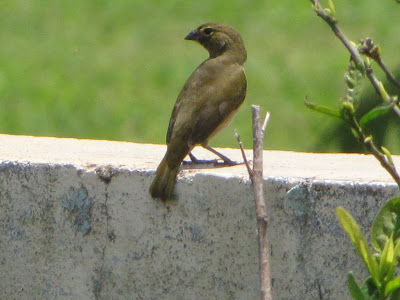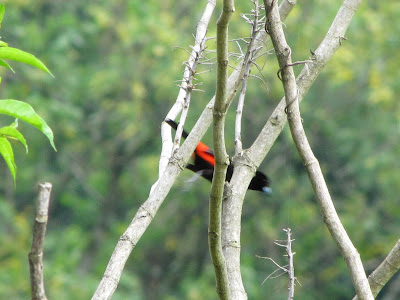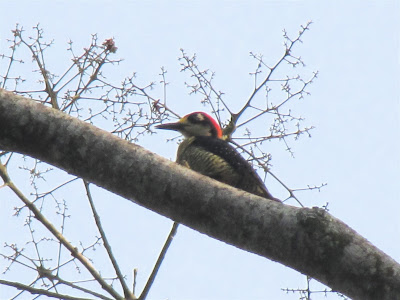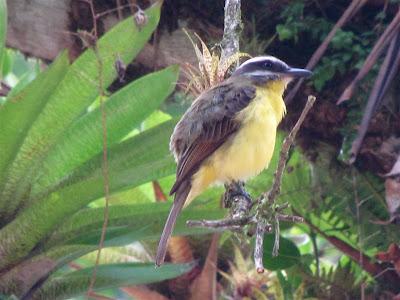
 Scientific Name: Sialia currucoides
Scientific Name: Sialia currucoides
 Scientific Name: Sialia currucoides
Scientific Name: Sialia currucoides




 Scientific Name: Lepidocolaptes souleyetii
Scientific Name: Lepidocolaptes souleyetii 
Population Estimate: 50-500K
Range / Habitat: Subtropical / tropical montane (800-2500m) moist forest of southern Mexico and Central America.
Field Notes: Small green hummingbird with thin, straight bill. Prominent rufous wing and white outer rectrices in both sexes. Female with white throat and belly. Black-bellied Hummingbird similar but with black face and belly.
Personal Notes: Seen at Monteverde Cloud Forest Reserve





Scientific Name: Geothlypis poliocephala
Population Estimate: 500K to 5M
Range / Habitat: Lowland shrub land, grass land, degraded former forest in southern Mexico and Central America.
Field Notes: Warbler with relatively large bill, yellow underparts, olive upperparts. Grey crown and small black mask distinguish it from Olive-crowned Yellowthroat, Common Yellowthroat, and Masked Yellowthroat.
Personal Notes: Seen in Monteverde area, Costa Rica

Scientific Name: Thamnophilus bridgesi
Population Estimate: Unknown, but Least Concern status
Range / Habitat: Tropical lowland moist forest of Costa Rica and Panama.
Field Notes: Medium-sized passerine with thick, hooked bill. Overall dark grey to black, both sexes with white speckling on shoulder. Male otherwise undistinguished. Female with additional white barring over head, neck and breast.
Personal Notes: Seen at Manuel Antonio, Costa Rica






 Scientific Name: Tinamus major
Scientific Name: Tinamus major
Scientific Name: Phaeothlypis fulvicauda
Population Estimate: Unknown, but Least Concern status
Range / Habitat: Lowland moist forest and inland wetlands in Central America and northern South America.
Field Notes: Long-tailed warbler with with dark brown head, back and tail. Buff underparts, eyebrow, and rump. The above photo is a juvenile of the species.
Personal Notes: Seen at Arenal Hanging Bridges, Costa Rica



Scientific Name: Heliomaster longirostris
Population Estimate: 500K to 5M
Range / Habitat: Subtropical / tropical lowland moist forest from southern Mexico, through Central America, down through much of South America.
Field Notes: Hummingbird with long, straight bill. Back is mottled olive and white, buffy underparts. Facial pattern is distinctive with blue cap and pink throat, though color not apparent in photo above. White postocular spot distinguishes from Plain-capped Starthroat.
Personal Notes: Seen at Arenal Nayara Hotel, Costa Rica


Scientific Name: Melanerpes pucherani
Population Estimate: 50-500K
Range / Habitat: Subtropical / tropical lowland moist forest in southern Mexico, Central America, and northwestern South America.
Field Notes: Medium-sized woodpecker with red nape in both male and female, black cheek and white postocular spot. Yellow tuft at base of bill. Black and white ladder pattern on back. Light grey horizontal stripes on belly. Similar to Golden-naped Woodpecker but no range overlap.
Personal Notes: Seen at Arenal Nayara Hotel, Costa Rica


Scientific Name: Synallaxis brachyura
Population Estimate: Unknown, but Least Concern status
Range / Habitat: Central America and northwestern South America lowlands and foothills up to 1500m in a range of scrubby habitats, including second growth, road and river edges, and overgrown pasture.
Field Notes: Medium-sized passerine with long, tapered tail that can splay out in a distinctive way as above. Overall dark grey bird with tawny cap and wings. Pale-breasted Spinetail is less dark grey overall with light breast.
Personal Notes: Seen at Arenal Nayara Hotel, Costa Rica


Scientific Name: Sclerurus albigularis
Population Estimate: Unknown, but Least Concern status
Range / Habitat: Subtropical / tropical montane moist forest in Central America, northern South American, Trinidad and Tobago.
Field Notes: Medium-sized thrush-type bird with relatively long, thick, decurved bill and short tail. Overall brown with light grey throat.
Personal Notes: Seen at Monteverde Cloud Forest Reserve, Costa Rica









Scientific Name: Platyrinchus coronatus
Population Estimate: Unknown, but Least Concern status
Range / Habitat: Subtropical / tropical lowland moist and swamp forest areas in Central America and northern South America.
Field Notes: Small, stubby passerine with nearly absent tail and broad bill. Facial features characteristic of spadebills: dark crown with black postocular and malar stripe on otherwise white face. White eyering. Olive back and rust-colored crown distinguish it from other spadebills.
Personal Notes: Seen at Carara National Park, Costa Rica

Scientific Name: Campylorhynchus rufinucha
Population Estimate: 50-500K
Range / Habitat: Lowland dry shrub land of southern Mexico and Central America
Field Notes: Large wren with distinctive black and white striped head, red eye, rufous nape and back, barring on wings and tail.
Personal Notes: En route Monteverde to Carara, Costa Rica



Scientific Name: Melanerpes rubricapillus
Population Estimate: Unknown, but Least Concern status
Range / Habitat: Lowland dry forest in Costa Rica, Panama, Colombia, Venezuela, and Trinidad and Tobago
Field Notes: Medium-sized woodpecker with plain white face, neck and chest. Black and white ladder back. Males with distinctive red crown and nape. Females with subtle red nape only. Red belly patch in both sexes, which is often difficult to see. Hoffmann's Woodpecker has yellow nape in both sexes.
Personal Notes: Seen at Manuel Antonio, Costa Rica

Scientific Name: Picumnus olivaceus
Population Estimate: Unknown, but Least Concern status
Range / Habitat: Subtropical / tropical lowland and montane moist forest in Central American and northwestern South America.
Field Notes: Very small (4”) woodpecker with olive back, black speckled head, and black tail with white central rectrices.
Personal Notes: Seen at Manuel Antonio, Costa Rica

Scientific Name: Chiroxiphia linearis
Population Estimate: 50-500K
Range / Habitat: Mature moist and dry forest up to 1500m elevation in southern Mexico and Central America.
Field Notes: Small passerine with distinctive, liquid call. Males black with red cap, blue wings, and long, thin central rectrices. Female olive brown with black face, red cap, and much shorter central rectrices. Very similar to Lance-tailed Manakin, but no range overlap.
Personal Notes: Seen in the rain forest between Monteverde Lodge and a large private reserve in Costa Rica



Scientific Name: Trogon rufus
Population Estimate: Unknown, but Least Concern status
Range / Habitat: Subtropical / tropical lowland moist forest in Central America and throughout South America.
Field Notes: Both sexes with yellow breast and bill, pale eye ring. Male with green head and dark throat. Female with brown head. Violaceous Trogon has yellow eye ring and grey bill.
Personal Notes: Seen at Carara National Park, Costa Rica.